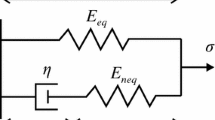Abstract
In this research, the incorporation of material anisotropy is proposed for the large-deformation analyses of highly flexible dynamical systems. The anisotropic effects are studied in terms of a generalized elastic forces (GEFs) derivation for a continuum-based, thick, and fully parameterized absolute nodal coordinate formulation plate element, of which the membrane and bending deformation effects are coupled. The GEFs are first derived for a fully anisotropic, linearly elastic material, characterized by 21 independent material parameters. Using the same approach, the GEFs are obtained for an orthotropic material, characterized by nine material parameters. Furthermore, the analysis is extended to the case of nonlinear elasticity; the GEFs are introduced for a nonlinear Cauchy-elastic material, characterized by four in-plane orthotropic material parameters. Numerical simulations are performed to validate the theory for statics and dynamics and to observe the anisotropic responses in terms of displacements, stresses, and strains. The presented formulations are suitable for studying the nonlinear dynamical behavior of advanced elastic materials of an arbitrary degree of anisotropy.












Similar content being viewed by others
References
Abbas, L.K., Rui, X., Hammoudi, Z.S.: Plate/shell element of variable thickness based on the absolute nodal coordinate formulation. Nonlinear Dyn. 224, 127–141 (2010)
Abbas, L., Rui, X., Marzocca, P.: Panel flutter analysis of plate element based on the absolute nodal coordinate formulation. Multibody Syst. Dyn. 27, 135–152 (2012)
Avril, S., Bonnet, M., Bretelle, A., Grédiac, M., Hild, F., Ienny, P., Latourte, F., Lemosse, D., Pagano, S., Pagnacco, E., Pierron, F.: Overview of identification methods of mechanical parameters based on full-field measurements. Exp. Mech. 48, 381–402 (2008)
Bronstein, I.N., Semendyayev, M.G.: Handbook of Mathematics, 4th edn. Springer, Berlin (2003)
Burden, R.L., Faires, D.J.: Numerical Analysis, 9th edn. Brooks Cole, California (2010)
Čepon, G., Boltežar, M.: Dynamics of a belt-drive system using a linear complementarity problem for the belt-pulley contact description. J. Sound Vib. 319(3–5), 1019–1035 (2009)
Čepon, G., Manin, L., Boltežar, M.: Introduction of damping into the flexible multibody belt-drive model: a numerical and experimental investigation. J. Sound Vib. 324(1–2), 283–296 (2009)
Cho, S.H., Kim, G., McCarthy, T.J., Farris, R.J.: Orthotropic elastic constants for polyimide film. Polym. Eng. Sci. 41(2), 301–307 (2001)
Dmitrochenko, O.: Finite elements using absolute nodal coordinates for large-deformation flexible multibody dynamics. J. Comput. Appl. Math. 215(2), 368–377 (2008)
Dmitrochenko, O., Mikkola, A.: A formal procedure and invariants of a transition from conventional finite elements to the absolute nodal coordinate formulation. Multibody Syst. Dyn. 22, 323–339 (2009)
Dufva, K., Kerkkänen, K., Maqueda, L.G., Shabana, A.A.: Nonlinear dynamics of three-dimensional belt drives using the finite-element method. Nonlinear Dyn. 48(4), 449–466 (2007)
Hussein, B., Negrut, D., Shabana, A.A.: Implicit and explicit integration in the solution of the absolute nodal coordinate differential/algebraic equations. Nonlinear Dyn. 54, 283–296 (2008)
Kerkkänen, K., GarcíaVallejo, D., Mikkola, A.: Modeling of belt-drives using a large deformation finite element formulation. Nonlinear Dyn. 43, 239–256 (2006)
Langerholc, M., Česnik, M., Slavič, J., Boltežar, M.: Experimental validation of a complex, large-scale, rigid-body mechanism. Eng. Struct. 36, 220–227 (2012)
Langerholc, M., Slavič, J., Boltežar, M.: Absolute nodal coordinates in digital image correlation. Exp. Mech. (2012). doi:10.1007/s11340-012-9691-4
Maqueda, L.G., Mohamed, A.N.A., Shabana, A.A.: Use of general nonlinear material models in beam problems: application to belts and rubber chains. J. Comput. Nonlinear Dyn. 5(2), 021003 (2010)
Maqueda, L.G., Shabana, A.A.: Poisson modes and general nonlinear constitutive models in the large displacement analysis of beams. Multibody Syst. Dyn. 18(3), 375–396 (2007)
Mikkola, A., Shabana, A.A.: A non-incremental finite element procedure for the analysis of large deformation of plates and shells in mechanical system applications. Multibody Syst. Dyn. 9, 283–309 (2003)
Nada, A., El-Assal, A.: Absolute nodal coordinate formulation of large-deformation piezoelectric laminated plates. Nonlinear Dyn. 67, 2441–2454 (2012)
Newnham, R.E.: Properties of Materials: Anisotropy, Symmetry, Structure. Oxford University Press, London (2005)
Pogorelov, D., Dmitrochenko, O.: Generalization of plate finite elements for absolute nodal coordinate formulation. Multibody Syst. Dyn. 10(1), 17–43 (2003)
Shabana, A.A.: Computational Dynamics, 3rd edn. Wiley, New York (2010)
Shabana, A.A.: Computational Continuum Mechanics. Cambridge University Press, Cambridge (2008)
Schwab, A.L., Gerstmayr, J., Meijaard, J.P.: Comparison of three-dimensional flexible thin plate elements for multibody dynamic analysis: finite element formulation and absolute nodal coordinate formulation. ASME Conf. Proc. 4806X, 1059–1070 (2007)
Sugiyama, H., Shabana, A.A.: Application of plasticity theory and absolute nodal coordinate formulation to flexible multibody system dynamics. J. Mech. Des. 126(3), 478–487 (2004)
Sugiyama, H., Shabana, A.A.: On the use of implicit integration methods and the absolute nodal coordinate formulation in the analysis of elasto-plastic deformation problems. Nonlinear Dyn. 37, 245–270 (2004)
Tian, Q., Liu, C., Machado, M., Flores, P.: A new model for dry and lubricated cylindrical joints with clearance in spatial flexible multibody systems. Nonlinear Dyn. 64, 25–47 (2011)
Yoo, P.S., Pogorelov, D., Dmitrochenko, O.: Large deflection analysis of a thin plate: computer simulations and experiments. Multibody Syst. Dyn. 11, 185–208 (2004)
Yu, L., Ren, G.T.: Integration of absolute nodal elements into multibody system. Nonlinear Dyn. 62, 931–943 (2010)
Acknowledgement
The operation was partially financed by the European Union, European Social Fund.
Author information
Authors and Affiliations
Corresponding author
Appendix
Appendix
The element shape-function matrix S is defined as
where I is a 3×3 identity matrix, and

where a, b, and h are the length, width, and height of the element, respectively. The presented shape function S ensures positions and position-vector gradients’ continuity at the nodal points; however, it does not ensure the gradients’ continuity at the element’s interface.
Rights and permissions
About this article
Cite this article
Langerholc, M., Slavič, J. & Boltežar, M. A thick anisotropic plate element in the framework of an absolute nodal coordinate formulation. Nonlinear Dyn 73, 183–198 (2013). https://doi.org/10.1007/s11071-013-0778-y
Received:
Accepted:
Published:
Issue Date:
DOI: https://doi.org/10.1007/s11071-013-0778-y



